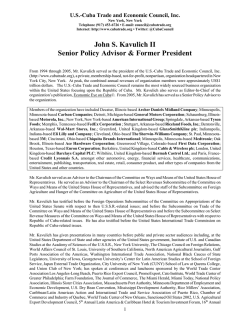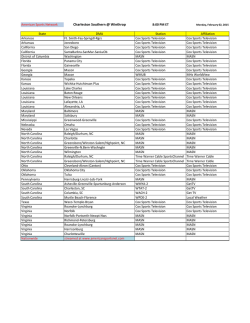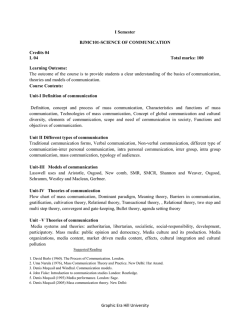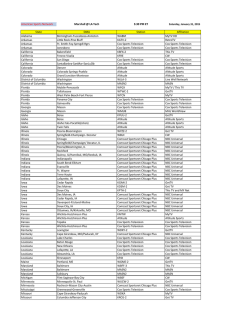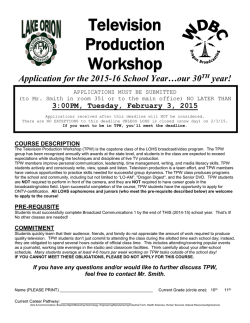
Social media and television: a bibliographic review based
ARTÍCULOS Social media and television: a bibliographic review based on the Web of Science Medios sociales y televisión: revisión bibliográfica a partir de la Web of Science Francisco Segado, María-del-Mar Grandío and Erika Fernández-Gómez Francisco Segado-Boj holds a B.A. Degree in Journalism and a Ph.D. Degree in Communication from the Complutense University of Madrid (UCM). He is an associate professor at Universidad Internacional de la Rioja (UNIR), where he coordinates the doctoral programme Knowledge so‐ ciety and action in the fields of education, communication, rights and new technologies. Former research fellow at UCM and visiting scholar at University of Central Lancashire. Current director of the Digital Communication & Society (Coysodi) research group. His work focuses on digital communication (social media and digital journalism), science communication and political cartoons. He has published around twenty papers about these issues in scientific journals such as Telematics & informatics, First Monday, Historia crítica, Telos, Revista latina de comunicación social, Comuni‐ cación y sociedad, or Hispania, among others. http://orcid.org/0000-0001-7750-3755 Universidad Internacional de la Rioja Gran Vía Rey Juan Carlos I, 41. 26002 Logroño (La Rioja), España [email protected] María-del-Mar Grandío is an assistant professor at the School of Communication and Information Studies in the University of Murcia. She lectures on audiovisual fiction and transmedia storytelling. She has been member of the Management Committee of the COST Action “Transforming audiences, transforming societies” (2010-2014) and currently in the COST Action “New possibilities for print and digital media” (2012-2015). Co-author of Sharing economy (EOI, 2014) and Strategies of communion in social media (Gedisa, 2013). She focuses her research on reception studies and new media consume, transmedia audiences and fandom. Index h=9 in Google Scholar. http://orcid.org/0000-0002-2577-4059 Universidad de Murcia, Facultad de Comunicación y Documentación Campus de Espinardo. 30100 Murcia, España [email protected] Erika Fernández-Gómez is an assistant professor at Universidad Internacional de La Rioja (UNIR). She got her PhD in the University of Vigo with European mention. She has a degree on Advertising and public relations from the same university and she is specialized in advertising and media management. She is accredited by Aneca. She teaches at UNIR since 2010 in the Degrees in communi‐ cation and marketing and in the Master degree in audiovisual scripting. She is part of the research group Digital Communication and Society (Coysodi). Her research interests focus on television (especially fiction), advertising, child audience, and social networks. She carried out her doctoral thesis about the Spanish second public channel (La 2) and its shows aimed at young targets. http://orcid.org/0000-0002-7088-1814 Universidad Internacional de La Rioja, Facultad de Empresa y Comunicación Gran Vía Rey Juan Carlos I, 41. 26002 Logroño (La Rioja), España [email protected] Article received on 09-02-2015 Approved on: 25-03-2015 El profesional de la información, 2015, mayo-junio, v. 24, n. 3. eISSN: 1699-2407 227 Francisco Segado, María-del-Mar Grandío and Erika Fernández-Gómez Abstract One of the most important trends in current television research has to do with the increasing impact of social media on viewing and consumption. This article reviews the literature on social media and television included in the Web of Science database from 2005 to 2013 in order to find the main research questions guiding academic research within media studies. The topics investigated included the theoretical approach and definition of social television, the central role of Twitter as the main social tool for second-screen activities, the prominence of “reality TV” as the most social genre on television, and new mainstream forms of television fandom. The conclusion of this article reflects on possible limitations of these studies and new paths of research. Keywords Social television; Social media; Twitter; Audiences; Review; Web of Science. Resumen Una de las principales tendencias en la investigación actual sobre televisión se centra en el creciente papel de los medios sociales en el consumo televisivo. Este artículo revisa la bibliografía encontrada sobre medios sociales y televisión en la base de datos bibliográfica Web of Science desde 2005 a 2013. El objetivo es resaltar las cuestiones de investigación que están liderando el estudio tales como el debate sobre la definición de televisión social, el papel central de Twitter como principal herramienta social para la realización de actividades de “segunda pantalla”, los formatos de tele-realidad como los más comentados en las redes sociales, junto con otras formas de expresión del fenómeno fan. Las conclusiones de este artículo reflexionan sobre posibles limitaciones de estos análysis y subraya nuevas líneas de investigación. Palabras clave Televisión social; Medios sociales; Twitter; Audiencias; Revisión; Web of Science. Segado, Francisco; Grandío, María-del-Mar; Fernández-Gómez, Erika (2015). “Social media and television: a bibliographic review on the Web of Science”. El profesional de la información, v. 24, n. 3, mayo-junio, pp. 227-234. http://dx.doi.org/10.3145/epi.2015.may.02 1. Introduction Television watching has always been social (Lull, 1980). However, the impact of new technologies on viewing has radically changed how audiences respond to TV programs. Since the 90’s, the permeation of the internet and other new digital communication technologies has provoked deep changes in the so-called legacy media, including transformations in television consumption and production patterns (Owen, 1999; Cesar; Chorianopoulos; Jensen, 2008; Hamaguchi et al., 2012; Noguera et al., 2014). In this new context, where television converges with the internet, new challenges must be addressed not only by the industry but also by researchers. A new kind of advanced television sets which allow non-physical-group TV watching, present information and online communication, as well as support recommendations of TV shows and channels has been developed under the generic label of ‘Social television’ (Gross; Fetter; Paul-Stueve, 2008). Along with the creation of new television systems, social networks such as Twitter and Facebook play a relevant role in making television a more pleasurable experience. In recent years there has been an increase in the number of papers by scholars studying the role of the audience and the strategies employed by television in this volatile marketplace. This article analyzes the methods, limitations, and conclusions of these studies in the social television field and highlights the main themes represented in the most important database on academic publications: the Web of Science. This review seeks to determine how scholars in Social Scien228 ces, Media and Communication Studies, and other closely related disciplines, such as Psychology or Sociology, are studying the possible relationships and influences of social media on current television consumption. Along with the creation of new television systems, social networks such as Twitter and Facebook play a relevant role in making television a more pleasurable experience 2. Methodology This literature review covers articles from 2005 to 2013 that deal with both television broadcasting and social media (specifically social networking sites). In order to produce the highest quality list, only articles and conference papers indexed in the Web of Science (WoS) core collection were selected. These articles were retrieved by conducting multiple searches for items that included the topic ‘social television’ as well as the word ‘television’ and other terms related to social media and web 2.0. These terms were chosen following the same structure outlined in Gold et al. (2011) combining global labels such as ‘social media’ or ‘social network’, and other specific features and services such as ‘Facebook’. These search terms were employed to locate articles dealing with the wider concept of ‘social media’ and with El profesional de la información, 2015, mayo-junio, v. 24, n. 3. eISSN: 1699-2407 Social media and television: a bibliographic review based on the Web of Science H4. Most of the research about social media and television uses quantitative methods instead of qualitative or mixed methods. Table 1. Search terms employed to find articles in WoS core collection Topic = ‘Social television’ Topic = ‘Social media’ AND ‘Television’ Besides this quantitative and descriptive analysis, our review was also guided by the following exploratory research question and sub-questions: Topic = ‘Social network*’ AND ‘Television’ Topic = ‘Online communities’ AND ‘Television’ Topic = ‘Blogs’ AND ‘Television’ Topic = ‘Facebook’ AND ‘Television’ Topic = ‘Twitter’ AND ‘Television’ the most popular services of web 2.0 such as blogs and social networking sites (table 1). Initially 173 articles were retrieved using the search terms. Their abstracts were manually reviewed and articles were removed that did not specifically deal with the television viewer’s use of social media and the relationship between it and television. This left out of the sample several articles that mainly focused on one of these two elements but tangentially mentioned the other (e. g. Lieberman; Koetzle; Sakiyama, 2013; Fogel; Krausz, 2013; Wong; Gupta, 2011, to name a few); articles in which both elements were tangentially mentioned but the focus was a different topic altogether (as Protudjer et al., 2012 or McNeil; Brna; Gordon, 2012); or articles that were restricted to technical issues (such as Montpetit; Médard, 2012). After removing these articles, 39 remained and comprised the corpus of this study. The 39 articles were processed manually using content analysis to test the following hypotheses: H1. The number of articles about social media and television is growing. H2. Most of the research about social media and television is published mainly by Communication Studies journals. H3. Research on social media and television is mostly empirical, not theoretical. RQ1: What are the main areas of interest in the research on social media and television? RQ1.1 What are the research methods being used in these studies? RQ1.2 What are the limitations of these studies, so far? RQ1.3 What are the main conclusions in these studies? Following other systematic reviews (Schleidgen et al., 2013; Dyer; Das-Nair, 2012) a thematic analysis was used to extract the key issues studied in each article and to identify the aspects mentioned in the sub-questions. This analysis allowed us to identify the most relevant issues regarding social media and television as well as the main approaches and the issues that still remain unknown and unstudied by researchers. Quantitative approaches to the topics were used and global data will be presented. Predominant research topics on social television will be explained more indepth through a qualitative approach based on a thematic analysis on the selected papers. Fandom is much more than regular viewing and engagement with a television show 3. Quantitative results The total number of papers published about social television has been growing since 2006 (see figure 1). The concept of Social TV peaked in 2008, although it is still a relevant topic of study. Fandom shows a stable interest among researchers 9 8 7 6 5 4 3 2 1 0 2006 2007 2008 Total 2009 SocialTV 2010 Fandom 2011 2nd Screen 2012 2013 Promo Figure 1. Number of papers published per year and by topic El profesional de la información, 2015, mayo-junio, v. 24, n. 3. eISSN: 1699-2407 229 Francisco Segado, María-del-Mar Grandío and Erika Fernández-Gómez Table 2. Number and percentage of papers classified in WoS research areas by topic Social TV Fandom n % Computer Science 8 66,7 Engineering 7 Telecommunications 3 Communication Second screen n % Communication 3 37,5 58,3 Asian Studies 1 25,0 Cultural Studies 1 1 8,33 Film, Radio & Television Information Science & Library Science 1 8,33 Psychology 1 Social Issues Social Sciences-Other Topics n % n % Communication 3 42,9 Communication 5 71,4 12,5 Sociology 2 12,5 Computer Science 1 28,6 Business & Economics 3 42,6 14,3 Computer Science 1 14,3 1 12,5 Engineering 1 14,3 Education & Educational Research 1 14,3 Humanities 1 12,5 Film, Radio & Television 1 14,3 Film Radio & Television 1 14,3 8,33 Literature 1 12,5 Government & Law 1 14,3 1 8,33 Multidisciplinary 1 12,5 Sport Sciences 1 14,3 1 8,33 Telecommunications 1 14,3 since 2006. Fandom is much more than regular viewing and engagement with a television show. It is a framework of taste, an identity and the sense of belonging to a particular community: those who consume and deeply get involved with a specific cultural product. The study of second-screen activities shows a steady increase since 2009. views, focus groups, etc.). Only seven papers included a theoretical approach to the study. Few papers combine both quantitative and qualitative perspectives or follow a mixed methodology such as network analysis (see figure 3). Regarding specific topics, articles about the use of social media as a second-screen and a promotional and marketing tool do prefer a quantitative approach; however, articles about social television and fandom show a tendency towards a theoretical and qualitative focus (see figure 3). According to the WoS classification of the journals’ research areas, the most interest in social television comes from Communication Studies, followed by Computer Sciences and Engineering (see figure 2). Slight differences exist between the disciplines and popularity of the four predominant topics; Computer Science and Engineering journals have published the most about social TV, while Communication journals published the most about second-screen activities (see table 2). 4. Qualitative results 4.1. Social television: making technology more social than ever Current research about new television systems which include social media features has dealt mainly with the way users interact in this new environment (Harboe et al., 2008; Metcalf et al., 2008) and the perceived usefulness of these devices (Shin, 2013). Most of the research on social television has used quantitative methods (surveys, content analysis) more frequently than qualitative tools (discourse analysis, in-depth inter- 45 Promo For Chorianopoulos and Lekakos (2008, p. 115) social television is an easy-to-use audiovisual system that gets viewers to communicate with each other by employing synchronous or asynchronous interpersonal communication modalities. Pagani and Mirabello define social television as: 41,02 40 35 28,2 30 25 20,5 20 12,8 15 10,26 10,26 10 7,7 5,1 5 5,1 gy cio In fo rm a4 o Te n le Sc co ie So So cia lo es su l Is br Li nc e & un i m m , R m Fil ar y ca 4o T & ad io no co E s & es sin Bu ns V m ics g ee rin gin En nc cie r S te Co m pu Co m m un ica 4o n e 0 Figure 2. Percentage of research areas of the Web of Science on social television. (Note: only areas where more than one paper was published are included) 230 El profesional de la información, 2015, mayo-junio, v. 24, n. 3. eISSN: 1699-2407 “an emerging new technology medium that supports and integrates social interaction, recommendations, ratings, reviews, and interactive participation among viewers via text chat, audio, or even videoconferencing” (2011, p. 43). According to these studies, social television is seen as an Social media and television: a bibliographic review based on the Web of Science adequate medium to provide distraction during commercial breaks and other slow parts of a show, but above all is seen as a tool to keep in contact with relatives and other loved ones (Harboe et al., 2008). Not surprisingly, sociability is one of the most valued features of these platforms (Metcalf et al., 2008, Shin, 2013). Shin (2013) concludes that users are mainly attracted to social television because of the social aspects. Network operators, such as cable television, are investigating multiplatform architecture to deliver a social media television experience to viewers. As explained by Carlucci (2010), social television explores the contributions of television, web-personal computer, and mobile components to the overall experience. Theore>cal 16 Quan>ta>ve Qualita>ve Mixed Combina>on (Qualita>ve + Quan>a>ve) 15 14 13 12 10 8 7 7 6 5 4 5 4 2 2 0 4 4 4 1 0 TOTAL 2 2 1 1 Fandom 2 1 0 Social TV 0 0 Second Screen 0 0 0 Promo Figure 3. Number of papers per methodology and by main topic of research. The hybridizing of television and computer offers new possibilities to enhance the enjoyment of viewing while forging greater affinity between group members based on shared viewing experiences. One of the first articles published on this issue was related to one specific group: the elderly. Sokoler and Sánchez-Svensson (2008) reported on an early experience with the design of a social television system for senior citizens that used the concept of “presence remote” making it possible for elderly people to notice others and be noticed by peers within their local neighborhood as they watched television. Another more recent article by Mu et al. (2013) proposed a web-based video storytelling system for members of a large community to edit, broadcast, and report their own stories, similar to what a professional television broadcaster does. Above all social television is seen as a tool to keep in contact with relatives and other loved ones (Harboe et al., 2008) 4.2. The role of social media in social television Social television researchers have focused much of their attention on social media as a second screen where the television consumption experience is expanded. Social conversation and interaction, implying television consumption, does not only take place in specific television systems, but also through conventional social media and social networking sites. Diakopoulos and Shamma (2010) explained the transformation of media events into “social video experiences” through a case study of conversation on Twitter about the first U.S. presidential television debate in 2008 between Barack Obama and John McCain. Highfield, Harrington and Bruns (2013) also explored Twitter as a backchannel of a Eurovision contest in Australia. Regarding methodology, the methods more frequently applied for analyzing and tracking the conversation on social media are discourse and content analysis (Norman, 2012; Anstead; O’Loughlin, 2011) and data analysis of social network maps (Larsson, 2013), level of interaction between users (Larsson, 2013; Anstead; O’Loughlin, 2011), frequency of messages (Anstead; O’Loughlin, 2011) or type of device used to tweet (Lochrie; Coulton, 2012). Other authors claim to employ complementary methods like virtual ethnographic techniques (Norman, 2012). A social television system for senior citizens used the concept of ‘presence remote’ making it possible for elderly people to notice others and be noticed by peers within their local neighborhood as they watched television These studies have found how the confluence of social media and television has established a new television consumption logic where the “viewer can use social media to publish and learn new information, and engage in discussion” (Anstead; O’Loughlin, 2011: p, 457). Social media has turned into a channel which “may offer a forum for public commentary on and symbolic resistance” to certain issues (Norman, 2012: p. 316). Future studies should investigate to what extent social media comments about television programs reinforce or undermine the dominant discourses in traditional media. El profesional de la información, 2015, mayo-junio, v. 24, n. 3. eISSN: 1699-2407 231 Francisco Segado, María-del-Mar Grandío and Erika Fernández-Gómez 4.3. Relationship between social television and reality TV 4.5. New expressions on TV fandom as a mainstream activity The correlation between reality television consumption and the use of social media has been tested through various studies (Stefanone; Lackaff, 2009; Stefanone; Lackaff; Rosen, 2010). According to these studies reality television consumption is positively related to: time spent in social networking site profiles, the number of connections a user has on social networking sites, the proportion of users’ connections in online social networks who they have never met face-toface, and the tendency to share their photographs on social networking sites (Stefanone; Lackaff; Rosen, 2010). Yet, this correlation does not imply causation between exposure to reality television and the use of social media. As the authors of these studies remark, these studies do not consider other factors such as personality (voyeuristic trends, for instance) or different preferences toward subgenres of reality television (Stefanone; Lackaff; Rosen, 2010). Social television has changed the way fandom feels and expresses itself through new media. Fandom is still a selfawareness and self-determination of fans as fans. But one of the new characteristics is the “mainstreaming of fandom”, quite different from the previous understanding of the term based on cult status and unique elite. Leora Hadas and Limor Shifman studied the fan-producer relationship with a case study of the TV series Doctor Who, a cult series revived by a fan turned producer. This case study demonstrates how fans do not present resistance to the mainstream. In their view, fandom must acknowledge that even if web 2.0 platforms make it easy for fans to get organized and express their opinions, their position is no more privileged than it has ever been (2013). Future studies should investigate to what extent social media comments about TV programs reinforce or undermine the dominant discourses in traditional media 4.4. Social networks as a promotional tool for TV content Scientific literature shows how social networks have not only changed television consumption patterns but they have also affected the way in which television channels promote their content through these new tools as they seek a higher level of engagement from their audience. Greer and Ferguson (2011) conducted a study focused on Twitter users to determine what these viewers-followers liked the most about their favorite sites and their motivations for following local television on microblogging networks. Their study concluded that Twitter could be useful to understand the preferences of the audiences. Nevertheless, not all the viewers of a show use social networks actively. The use of second-screen strategies via the internet increases audience involvement and contributes to the success of television shows. Ytreberg (2009) concluded that the international success of formats such as Pop (American) Idol and Big Brother at the beginning of the millennium could partly be attributed to the rise of a working formula for combining broadcasting with digital platforms. Pagani and Mirabello (2011), through an online sample of 814 European and American users, remarked that participation and interaction in TV web sites such as Veetle TV or Loom TV are boosted by the richness of applications and content offered to users. Campbell (2011) carried out a case study focused on iVilla‐ ge, an online community aimed at women that is part of the NBC Group; the article presents how consumers in this community get actively involved in promoting corporate brands through their user-generated content. 232 The use of second-screen strategies via the internet increases audience involvement and contributes to the success of television shows 5. Conclusions This review highlights the increasing importance of social television within high-profile academic research, especially within communication and computer science fields. The main conclusions highlight how viewers are attracted to social television because of its social aspects (connection to their peers, conversation, and second-screen activities). This review also found a lack of studies about the routines and habits of television viewers on social platforms other than Twitter. New studies should explore how and why television viewers comment and interact with others through instant messaging services such as Telegram, Line, or Whatsapp. Regarding methods, very few studies employed user-centered methodologies, such as surveys or focus groups, or in-depth interviews. Social television research should combine quantitative and qualitative methodologies to explain the motivations and reasons which drive users to comment, who users expect to read their comments, and what kind of information they expect to find on social media. Also, studies should expand and cover more cases and scenarios. Most papers analyzed are reduced to comments on a unique case (one show) and one cultural scenario (users from only one country). A cross-cultural approach on social television should be undertaken, along with a wider perspective of the phenomenon taking into account the multiplatform consumption of television within a transmedia scenario. Note This work is partially funded by UNIR Research (http:// research.unir.net), Universidad Internacional de La Rioja (UNIR, http://www.unir.net), under the Research Support Strategy [2013-2015] El profesional de la información, 2015, mayo-junio, v. 24, n. 3. eISSN: 1699-2407 Social media and television: a bibliographic review based on the Web of Science References Anstead, Nick; O’Loughlin, Ben (2011). “The emerging viewertariat and BBC question time: television debate and real-time commenting online”. The international journal of press/politics, v. 16, n. 4, pp. 440-462. http://goo.gl/8l6f4O http://dx.doi.org/10.1177/1940161211415519 Campbell, John-Edward (2011). “It takes an iVillage: Gender, labor, and community in the age of television-internet convergence”. Intl journal of communication, v. 5, pp. 492-510. http://ijoc.org/index.php/ijoc/article/view/531/535 Carlucci, John (2010). “Social media television in today’s cable systems”. In: 7th Consumer communications and networ‐ king conf (CCNC), IEEE, pp. 1-5. http://dx.doi.org/10.1109/CCNC.2010.5421636 Cesar, Pablo; Chorianopoulos, Konstantinos; Jensen, Jens F. (2008). “Social television and user interaction”. ACM Com‐ put. entertain., v. 6, n. 1, pp. 1-12. http://doi.acm.org/10.1145/1350843.1350847 Chorianopoulos, Konstantinos; Lekakos, George (2008). “Introduction to social TV: Enhancing the shared experience with interactive TV”. International journal of human-compu‐ ter interaction, v. 24, n. 2, pp. 113-120. http://dx.doi.org/10.1080/10447310701821574 Diakopoulos, Nicholas A.; Shamma, David A. (2010). “Characterizing debate performance via aggregated Twitter sentiment”. In: Procs of the Sigchi Conf on human factors in computing systems, pp. 1195-1198. http://www.nickdiakopoulos.com/wp-content/uploads/2007/05/ note0655-diakopoulos.pdf http://dx.doi.org/10.1145/1753326.1753504 Dyer, Kerry; Das-Nair, Roshan (2013). “Why don’t healthcare professionals talk about sex? A systematic review of recent qualitative studies conducted in the United Kingdom”. The journal of sexual medicine, v. 10, n. 11, pp. 2658-2670. http://dx.doi.org/10.1111/j.1743-6109.2012.02856.x Fogel, Joshua; Krausz, Faye (2013). “Watching reality television beauty shows is associated with tanning lamp use and outdoor tanning among college students”. Journal of the American Academy of Dermatology, v. 68, n. 5, pp. 784-789. http://dx.doi.org/10.1016/j.jaad.2012.09.055 Gold, Judy; Pedrana, Alisa E.; Sacks-Davis, Rachel; Hellard, Margaret E.; Chang, Shanton; Howard, Steve; Keogh, Louise; Hocking, Jane S.; Stoove, Mark A. (2011). “A systematic examination of the use of online social networking sites for sexual health promotion”. BMC public health, v. 11. http://www.biomedcentral.com/content/pdf/1471-245811-583.pdf http://dx.doi.org/10.1186/1471-2458-11-583 Greer, Clark F.; Ferguson, Douglas A. (2011). “Using Twitter for promotion and branding: A content analysis of local television Twitter sites”. Journal of broadcasting & electronic media, v. 55, n. 2, pp. 198-214. http://dx.doi.org/10.1080/08838151.2011.570824 Gross, Tom; Fetter, Mirko; Paul-Stueve, Thilo (2008). “Toward advanced social TV in a cooperative media space”. International journal of human–computer interaction, v. 24, n. 2, pp. 155-173. http://dx.doi.org/10.1080/10447310701821491 Hadas, Leora; Shifman, Limor (2013). “Keeping the elite powerless: Fan-producer relations in the ‘nu who’ (and new YOU) era”. Critical studies in media communication, v. 30, n. 4, pp. 275-291. http://dx.doi.org/10.1080/15295036.2012.676193 Hamaguchi, Narichika; Miyazaki, Masaru; Nishimura, Satoshi; Fujisawa, Hiroshi (2012). “User behaviour analysis in social TV systems”. In: IEEE Intl conf on consumer electronics (ICCE), pp. 191-192. http://dx.doi.org/10.1109/ICCE.2012.6161823 Harboe, Gunnar; Massey, Noel; Metcalf, Crysta; Wheatley, David; Romano, Guy (2008). “The uses of social television”. Computers in entertainment (CIE), v. 6, n. 1, pp. 1-15. http://dx.doi.org/10.1145/1350843.1350851 Highfield, Tim; Harrington, Stephen; Bruns, Axel (2013). “Twitter as a technology for audiencing and fandom: The #Eurovision phenomenon”. Information, communication & society, v. 16, n. 3, pp. 315-339. http://goo.gl/Ml3S65 http://dx.doi.org/10.1080/1369118X.2012.756053 Larsson, Anders-Olof (2013). “Tweeting the viewer—use of Twitter in a talk show context”. Journal of broadcasting & electronic media, v. 57, n. 2, pp. 135-152. http://dx.doi.org/10.1080/08838151.2013.787081 Lieberman, Joel; Koetzle, Deborah; Sakiyama, Mari (2013). “Police departments’ use of Facebook: Patterns and policy issues”. Police quarterly, v. 16, n. 4, pp. 438-462. http://dx.doi.org/10.1177/1098611113495049 Lochrie, Mark; Coulton, Paul (2012). “Tweeting with the telly on! Mobile phones as second screen for TV”. In: Consu‐ mer communications and networking conf (CCNC) IEEE, pp. 729-731. http://core.ac.uk/download/pdf/1558628.pdf http://dx.doi.org/10.1109/CCNC.2012.6181037 Lull, James (1980). “The social uses of television”. Human communication research, v. 6, n. 3, pp. 197-209. http://dx.doi.org/10.1111/j.1468-2958.1980.tb00140.x McNeil, K.; Brna, Paula M.; Gordon, Kevin E. (2012). “Epilepsy in the Twitter era: a need to re-tweet the way we think about seizures”. Epilepsy & behavior, v. 23, n. 2, pp. 127-130. http://dx.doi.org/10.1016/j.yebeh.2011.10.020 Metcalf, Crysta; Harboe, Gunnar; Tullio, Joe; Massey, Noel; Romano, Guy; Huang, Elaine M.; Bentley, Frank (2008). “Examining presence and lightweight messaging in a social television experience”. Journal ACM transactions on multi‐ media computing, communications, and applications, v. 4, n. 4, pp. 27-16. http://web.mit.edu/bentley/Public/a27-metcalf.pdf http://dx.doi.org/10.1145/1412196.1412200 El profesional de la información, 2015, mayo-junio, v. 24, n. 3. eISSN: 1699-2407 233 Francisco Segado, María-del-Mar Grandío and Erika Fernández-Gómez Montpetit, Marie-Jose; Médard, Muriel (2012). “Social television: Enabling technologies and architectures”. In: Proceedings of the IEEE, v. 100 (Special centennial issue), pp. 1395-1399. http://ieeexplore.ieee.org/stamp/stamp.jsp?tp=&arnumber=6179504 http://dx.doi.org/10.1109/JPROC.2012.2189804 Mu, Mu; Simpson, Steven; Bojko, Craig; Broadbent, Matthew; Brown, James; Mauthe, Andreas; Race, Nicholas; Hutchison, David (2013). “Storisphere: From TV watching to community story telling” Communications magazi‐ ne IEEE, v. 51, n. 8, pp.112-119. http://dx.doi.org/10.1109/MCOM.2013.6576348 Noguera, José-Manuel; Martínez-Sánchez, Jesús; NicolásOjeda, Miguel-Ángel; Pérez-Escolar, Marta; Gómez-Company, Ariana; Grandío, María-del-Mar; Hernández-Gómez, Francisco; Sánchez-Cobarro, Paloma-del-Henar (2014). Economía de la participación. Madrid: Fundación EOI. ISBN: 978 84 15061 45 8 Norman, Mark (2012). “Saturday night’s alright for tweeting: cultural citizenship, collective discussion, and the new media consumption/production of Hockey day in Canada”. Sociology of sport journal, v. 29, n. 3, pp. 306-324. http://www.humankinetics.com/acucustom/sitename/ Documents/DocumentItem/03_norman_SSJ_2012_0012-ej.pdf Owen, Bruce M. (1999). The internet challenge to television. Cambridge: Harvard University Press. ISBN: 978 0674003897 Pagani, Margherita; Mirabello, Alessandra (2011). “The influence of personal and social-interactive engagement in social TV web sites”. Intl journal of electronic commerce, v. 16, n. 2, pp. 41-68. http://dx.doi.org/10.2753/JEC1086-4415160203 Protudjer, Jennifer-Lisa-Penner; McGavock, Jonathan M.; Ramsey, Clare, D.; Sevenhuysen, Gustaaf; Kozyrskyj, Anita L.; Becker, Allan B. (2012). “‘Asthma isn’t an excuse, it’s just a condition’: Youths’ perceptions of physical activity and screen time”. Journal of asthma, v. 49, n. 5, pp. 496-501. http://dx.doi.org/10.3109/02770903.2012.680637 234 Schleidgen, Sebastian; Klinger, Corinna; Bertram, Teresa; Rogowski, Wolf H.; Marckmann, Georg (2013). “What is personalized medicine: sharpening a vague term based on a systematic literature review”. BMC medical ethics, v. 14, n. 1. http://www.biomedcentral.com/1472-6939/14/55 http://dx.doi.org/10.1186/1472-6939-14-55 Shin, Dong-Hee (2013). “Defining sociability and social presence in social TV”. Computers in human behavior, v. 29, n. 3, pp. 939-947. http://dx.doi.org/10.1016/j.chb.2012.07.006 Sokoler, Tomas; Sánchez-Svensson, Marcus (2008). “PresenceRemote: Embracing ambiguity in the design of social TV for senior citizens”. Lecture notes in computer science, v. 5066, pp. 158-162. http://dx.doi.org/10.1007/978-3-540-69478-6_20 Stefanone, Michael A.; Lackaff, Derek (2009). “Reality television as a model for online behavior: Blogging, photo, and video sharing”. Journal of computer‐mediated communica‐ tion, v. 14, n. 4, pp. 964-987. http://onlinelibrary.wiley.com/doi/10.1111/j.10836101.2009.01477.x/pdf http://dx.doi.org/10.1111/j.1083-6101.2009.01477.x Stefanone, Michael A.; Lackaff, Derek; Rosen, Devan (2010). “The relationship between traditional mass media and ‘social media’: Reality television as a model for social network site behavior”. Journal of broadcasting & electronic media, v. 54, n. 3, pp. 508-525. http://dx.doi.org/10.1080/08838151.2010.498851 Wong, Wendy W.; Gupta, Subhas C. (2011). “Plastic surgery marketing in a generation of ‘tweeting’”. Aesthetic surgery journal, v. 31, n. 8, pp. 972-976. http://dx.doi.org/10.1177/1090820X11423764 Ytreberg, Espen (2009). “Extended liveness and eventfulness in multi-platform reality formats”. New media & socie‐ ty, v. 11, n. 4, pp. 467-485. http://dx.doi.org/10.1177/1461444809102955 El profesional de la información, 2015, mayo-junio, v. 24, n. 3. eISSN: 1699-2407
© Copyright 2025
